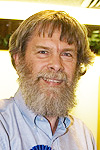Ready for a cool future
 |
|
David Harding
|
David Harding, acting head of the Technical Division, wrote this column.
This month the Technical Division celebrated the successful conclusion of a critical, multiyear upgrade to its helium liquefaction system in Industrial Building 1.
Liquid helium is essential to the testing and operation of all our superconducting devices, including both magnets and RF cavities. For decades, our liquefaction system was limited to providing about 225 liters of liquid helium per hour. Thanks to our successful upgrades, the system's capacity now is 350 liters per hour, an increase of more than 50 percent and consistent with the design capacity of the system.
Back in 2008, Ruben Carcagno and his team in the Test and Instrumentation Department laid out a plan to increase our liquefaction capacity to meet the rapidly increasing demand for liquid helium in IB1. How fast we can make liquid helium limits how many magnet and cavity tests we can run each week.
Many different parts of the liquefaction system needed to be upgraded or modified, and the work needed to be done with little disruption to our busy test program. Ruben and his team developed a plan to stage the work in blocks that could be accomplished during our annual, month-long maintenance period for the refrigeration system. Roger Rabehl from the T&I Department was the lead engineer for this project, and over the course of five years, the team patiently prepared for each opportunity and aggressively took advantage of each one to accomplish the task.
In December, during the holiday period, engineers and technicians ran the two final tests that showed we now can produce 350 liters per hour in a sustained run.
Liquid helium cools the magnets and cavities that we test to below minus 450 degrees Fahrenheit, only a few degrees above absolute zero. This allows us to operate devices in superconducting mode. When we cool a device, liquid helium warms up and starts to boil, turning into gas. Our system captures the gas, cools it with a special refrigerator to condense it again and reuses the liquid for more cooling.
One of the main tests we run involves superconducting magnets. We test them by increasing the current running through it until the magnet stops being superconducting and quenches. That point is the magnet's performance limit. Much of our design work focuses on increasing this limit so that we can build magnets with stronger magnetic fields. Years ago we realized that the testing of stronger and bigger magnets such as the quadrupole magnets for the LHC high-luminosity upgrade would require more liquid helium.
In recent years we have also started testing superconducting RF cavities for high-power particle accelerators. Since much of our R&D is aimed at improving the fabrication and processing of the cavities, we need to cool and test many cavities. Future projects will require the construction of many cavities and hence increase the demand for cooling capacity.
I congratulate the T&I Department and all the people across the Technical Division and the entire laboratory who were involved in this project. This is an important step to support Fermilab's future projects.
|